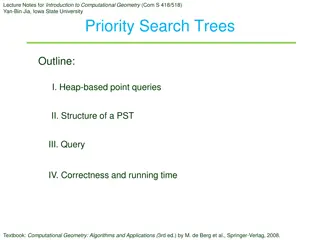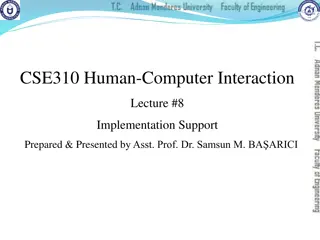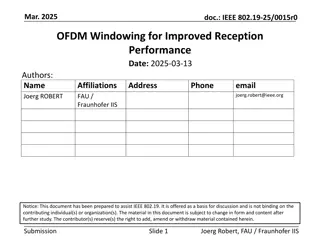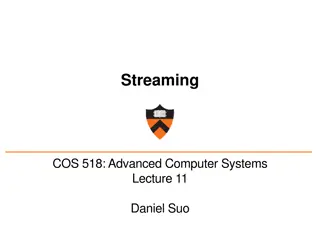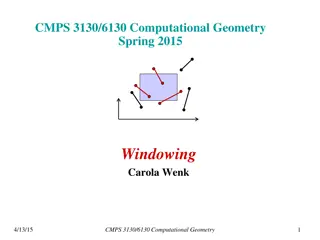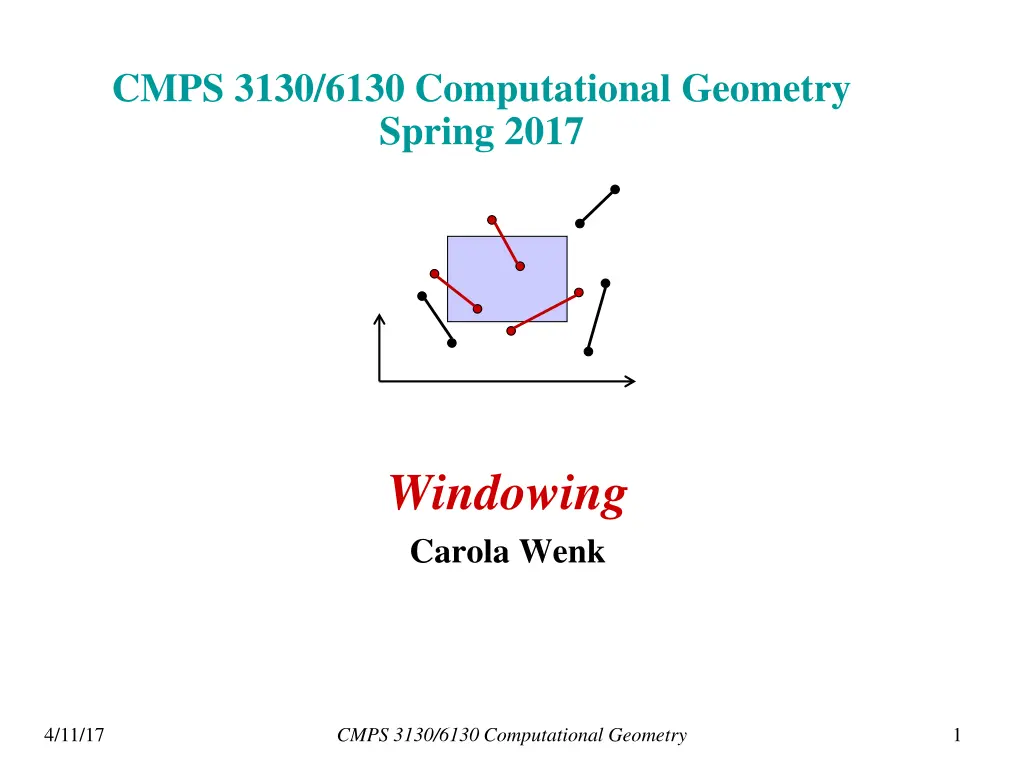
Computational Geometry Techniques in Windowing and Interval Trees
Explore the concepts of windowing and interval trees in computational geometry, including interval tree construction, query theorems, and segment tree partitioning. Learn how these techniques can efficiently process line segments, intervals, and query points in spatial data structures.
Download Presentation

Please find below an Image/Link to download the presentation.
The content on the website is provided AS IS for your information and personal use only. It may not be sold, licensed, or shared on other websites without obtaining consent from the author. If you encounter any issues during the download, it is possible that the publisher has removed the file from their server.
You are allowed to download the files provided on this website for personal or commercial use, subject to the condition that they are used lawfully. All files are the property of their respective owners.
The content on the website is provided AS IS for your information and personal use only. It may not be sold, licensed, or shared on other websites without obtaining consent from the author.
E N D
Presentation Transcript
CMPS 3130/6130 Computational Geometry Spring 2017 Windowing Carola Wenk 4/11/17 1 CMPS 3130/6130 Computational Geometry
Windowing Input: A set S of n line segments in the plane Query: Report all segments in S that intersect a given query window Subproblem: Process a set of intervals on the line into a data structure which supports queries of the type: Report all intervals that contain a query point. Interval trees Segment trees 4/11/17 2 CS 6463 AT: Computational Geometry
Interval Trees Input: A set I of n intervals on the line. disjoint union Idea: Partition I into Ileft Imid Iright where xmid is the median of the 2n endpoints. Store Imid twice as two lists of intervals: Lleft sorted by left endpoint and as Lright sorted by right endpoint. Imidstored as Lleft , Lright interval tree for Ileft interval tree for Iright 4/11/17 3 CMPS 3130/6130 Computational Geometry
Interval Trees Lemma: An interval tree on a set of n intervals uses O(n) space and has height O(log n). It can be constructed recursively in O(n log n). time. Proof: Each interval is stored in a set Imid only once, hence O(n) space. In the worst case half the intervals are to the left and right of xmid, hence the height is O(log n). Constructing the (sorted) lists takes O(|Iv| + |Ivmid| log |Ivmid|) time per vertex v. 4/11/17 4 CMPS 3130/6130 Computational Geometry
Interval Tree Query Theorem: An interval tree on a set of n intervals can be constructed in O(n log n) time and uses O(n) space. All intervals that contain a query point can be reported in O(log n + k) time, where k = #reported intervals. Proof: We spend O(1+kv) time at vertex v, where kv = #intervals reported at v. We visit at most 1 node at any depth. 4/11/17 5 CMPS 3130/6130 Computational Geometry
Segment Trees Let I={s1, ,sn}be a set of n intervals (segments), and let p1, p2, ,pmbe the sorted list of distinct interval endpoints of I. Partition the real line into elementary intervals: ,?1, ?1,?1, ?1,?2, , ?? 1,??, ??,??, ??, Construct a balanced binary search tree T with leaves corresponding to the elementary intervals p2 p5 p6 p3 p7 p1 p4 4/11/17 6
Elementary Intervals Int( ):=elementary interval corresponding to leaf Int(v):=union of Int( ) of all leaves in subtree rooted at v v Int(v) p2 p5 p6 p3 p7 p1 p4 4/11/17 7
Store segments as high as possible Segment Trees Each vertex v stores (1) Int(v) and (2) the canonical subset I(v) I: I(v):= {s I | Int(v) s and Int(parent(v)) s} s1 s2 s3 s4 s5 p2 p5 p6 p3 p7 p1 p4 4/11/17 8
Store segments as high as possible Segment Trees Each vertex v stores (1) Int(v) and (2) the canonical subset I(v) I: I(v):= {s I | Int(v) s and Int(parent(v)) s} p2 p5 p6 p3 p7 p1 p4 4/11/17 9
Space Lemma: A segment tree on n intervals uses O(n log n) space. Proof: Any interval s is stored in at most two sets I(v1), I(v2) for two different vertices v1, v2 at the same level of T. [If s was stored in I(v3) for a third vertex v3, then s would have to span from left to right, and Int(parent(v2)) s, hence s is cannot be stored in v2.] The tree is a balanced tree of height O(log n). s 4/11/17 10
Segment Tree Query Runtime Analysis: Visit one node per level. Spend O(1+kv) time per node v. Runtime O(log n + k) 4/11/17 11
Segment Tree Construction 1. Sort interval endpoints of I. elementary intervals 2. Construct balanced BST on elementary intervals. 3. Determine Int(v) bottom-up. 4. Compute canonical subsets by incrementally inserting intervals s=[x,x ] I into T using InsertSegmentTree: O(n log n) s ) s s s s ) s s ) 4/11/17 12
Segment Trees Runtime: Each interval stored at most twice per level At most one node per level that contains the left endpoint of s (same with right endpoint) Visit at most 4 nodes per level O(log n) per interval, and O(n log n) total Theorem: A segment tree for a set of n intervals can be built in O(n log n) time and uses O(n log n) space. All intervals that contain a query point can be reported in O(log n + k) time. 4/11/17 13
2D Windowing Revisited Input: A set S of n disjoint line segments in the plane Task: Process S into a data structure such that all segments intersecting a vertical query segment q:=qx [qy,q y] can be reported efficiently. q y qy qx 4/11/17 14 CS 6463 AT: Computational Geometry
2D Windowing Revisited Solution: Segment tree with nested range tree Build segment tree T based on x- intervals of segments in S. each Int(v) Int(v) (- , ) vertical slab I(v) S(v) canonical set of segments spanning vertical slab Store S(v) in 1D range tree (binary search tree) T(v) based on vertical order of segments 4/11/17 15 CS 6463 AT: Computational Geometry
2D Windowing Revisited Query algorithm: Search regularly for qx in T In every visited vertex v report segments in T(v) between qy and q y (1D range query) O(log n + kv) time for T(v) O(log2n + k) total q y qy qx 4/11/17 16 CS 6463 AT: Computational Geometry
2D Windowing Summary Theorem: Let S be a set of (interior-) disjoint line segments in the plane. The segments intersecting a vertical query segment (or an axis-parallel rectangular query window) can be reported in O(log2 n + k) time, with O(n logn) preprocessing time and O(n logn)space. q y qy qx 4/11/17 17 CS 6463 AT: Computational Geometry



